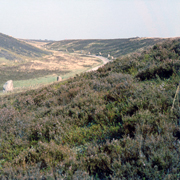
Kongenshus Mindepark
The International Carlo Scarpa Prize for Gardens
XV Annual Award, 2004
The Jury of the International Carlo Scarpa Prize for Gardens has decided unanimously to award the 2004 prize, the fifteenth in the series, to Kongenshus Mindepark, a tract of 1.200 hectares of heath located in the south of Viborg, Jutland (Denmark), witness to a long history of ideas and deeds, the inspiration for some astonishingly inventive landscape art.
A significant – and singular – set of events led during the first half of the 20th century to the protection of certain locations, including Kongenshus, which survived the agrarian transformation and land reclamation affecting much of the western part of the peninsula, following the Danish defeat in 1864 and the ensuing loss of Schleswig. This transformation came to be regarded as a true patriotic act.
What is significant is not so much the genesis of the idea of the heath’s beauty, which belongs to the broader European movement towards a new love of nature that developed throughout the 19th century, fostered by artistic élites, in particular by painters, cultured individuals, travellers, naturalists and curious anthropologists.
What is more significant is the fact that the State feels a duty to protect heath landscapes, so much so that the first restrictions appeared in 1903. Even more noteworthy is the fact that the idea of their value as a “heritage” appeared very early in the mentality of the Danish people, taking hold in the public consciousness and becoming capable of producing tangible initiatives. Indeed there is evidence that, as early as 1911, a group of Danish emigrants bought a tract of heath and donated it to the public authorities “on condition that it is preserved for ever in its natural state”.
But what is particularly striking, and almost paradoxical, is the fact that the initiative to safeguard and give value to the heath as a place of “memory” was fostered by the very workers who transformed it into agricultural land. In 1930 their associations proposed buying surviving tracts in order to guarantee their protection. A similar proposal resurfaced in 1937, with a call for the creation of a park dedicated to the memory of the heath’s inhabitants and the workers engaged in its transformation; the idea finally came to fruition in 1941 with the creation of an estate of 1.214 hectares corresponding to the present-day Kongenshus.
Yet just when, around 1945, a bright and windy expanse of moorland was dedicated to the aim of preserving and representing the collective memory, that love of nature which had brought about the protection of surviving tracts of heath was already being re-thought and enriched by the idea that in Denmark, like almost everywhere in the world, nature itself is a testimony to the past.
Text taken from the 2004 Carlo Scarpa Prize Statement, edited by the Jury.
